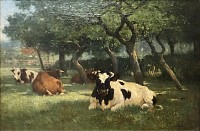BIOGRAPHY

1846-1929
William Henry Howe was born in Ravenna, Ohio in 1846. Of him it was written: "In the late nineteenth century no American artist was more thoroughly identified with the painting of cows than William Henry Howe." (Richter 128). In a style that combined Tonalism and Realism, he was a painter of light-filled pastoral landscapes that sometimes had sheep as well as cattle tended by their shepherds and herders.
He began a career as a businessman in St. Louis, and in his mid-thirties, changed course and went to Dusseldorf Germany to study art at the Royal Academy. In 1881, he went to Paris and studied with animal painters Felix Vuillefroy and Otto de Thoren. He also exhibited his work at the Paris Salons and the Paris Universal Exposition of 1889.
Travels in Holland in the 1880s with other artists inspired his interest in pastoral subjects, and during that time he began his cattle paintings, many with distinguishing facial expressions, that led him to be referred to as "Mr. Howe Cow". (Richter 128) One of his favorite painting places in Holland was the hamlet of Laren, where modern civilization seemed left behind and old-fashioned agrarian ways prevailed. Some American landscape painters including Howe created images between 1870 and 1900 that fed nostalgic leanings of many viewers who envisioned a golden-age past when life was serene and untroubled. They were also much influenced by French Barbizon painters such as Jean Millet and Constant Troyen who regularly left their studios in the city to paint bucolic countryside scenes near the small town of Barbizon.
His talent brought him illustration commissions from the Bull Turham Tobacco Company for whom he designed pouches with steer images as well as posters that were commonly seen pasted to barn walls at the turn of the century.
In 1893, Howe opened a studio in Bronxville, New York, having spent time in New Orleans in 1890. That year he signed and dated a painting of a local boy, Farm Scene with Negro Boy.
With Henry Ward Ranger, also a landscape painter, he founded the art colony at Old Lyme, Connecticut.
In New York City he later opened a studio on West 42nd Street. He was a member of the Salmagundi Club; National Academy of Design (elected Associate in 1894, Academician in 1897); Society of American Artists; National Institute of Arts and Letters, all in the City.
He exhibited and received awards at numerous exhibitions including: New Orleans Exposition, 1885; Paris Salon, 1886, 1888; Pennsylvania Academy of the Fine Arts, 1890; Crystal Palace, London, 1890; and Columbian Expo, Chicago, 1893. He also exhibited in the South Carolina Interstate and West Indian Exposition in 1901-02.
Howe's work is in the collections of the National Gallery of Art, Washington, D.C.; Carnegie Institute, Pittsburgh, Pennsylvania; St. Louis Museum, Missouri; and Cleveland Museum of Art, Ohio.
William Henry Howe died March 15, 1929 in Ravenna, Ohio.
